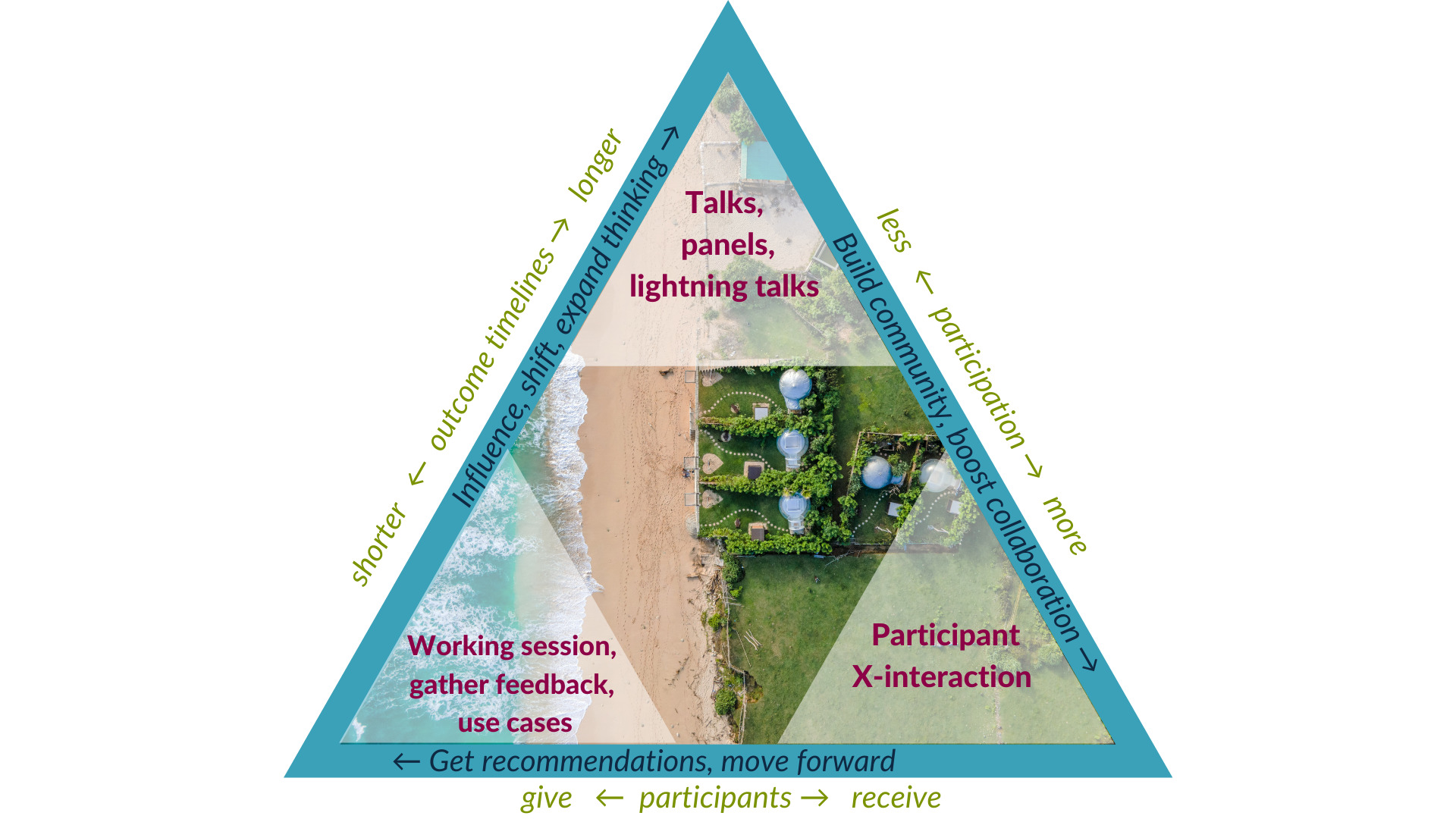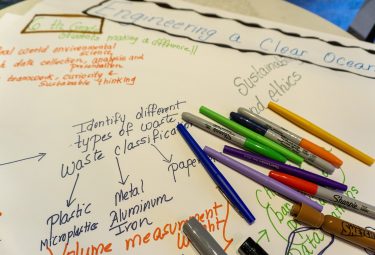Early bird rates are available for registration to the 2026 January ESIP Meeting. Register.
5 Tips to Organize a Great ESIP Meeting Session

Much like a coral reef, an inspiring meeting session builds through community.
A Christmas worm scuttles across brain coral. Image Credit: USGS
ESIP Meetings are not the kinds of gatherings where people check email, check their watches or check out. Or if they do, it’s probably because they’re juggling life, or the session organizer missed the chance to meet with our session design consultant and ESIP Community Director.
Haley’s past workshops with ESIP’s session organizers helped virtualize the dynamic, interactive vibe of live ESIP Meetings, which have been running for more than 20 years. Now ESIP is gearing up for the next meeting in Pittsburgh, PA this July.
In ESIP, we’ve chosen to focus on this session design matchmaking. We’re a community of doers and gather because we want to find collaborators and we want to work together. We want our ESIP Meetings to reflect that.
Each session is a stepping stone within a larger project’s path. Haley and Carter offer ideas to help make a strong connection and deliver clear information. Much to the delight of geoscientists, their pointers can be mapped on a ternary chart.
Join us in Pittsburgh for the July 2022 ESIP Meeting
The session proposal portal is open for the July 2022 ESIP Meeting through Friday, April 29. Once finalized, the agenda will be posted to Sched. Visit esipfed.org/meetings for general info and meeting details for registration, travel, hotel booking and virtual access.

Talks with less engagement, longer project timelines where the participants receive information tend to be traditional slide presentations, panels, and lightning talks. More interactive formats with more immediate project goals include working sessions where participants provide insights or recruitment-focused activities.
1. Design a conference session around one to three outcomes.
While planning a session, it’s easy to fall into the black hole of information overload. With back-to-back lightspeed talks and slides packed dense enough to pull stars out of orbit, the audience and the presenter don’t have a chance to catch their breath or remember why they gathered in the first place.
The solution: Be clear on what you want to get done during and after the session.
Plotting a session format (which can be done using Haley’s triangle) comes down to how much information needs to be shared weighed against setting aside enough time for authentic connection or gathering meaningful feedback. (Tip 5 outlines how to invite your speakers to get onboard, too.)
Since a single session can’t be everything to everyone, it’s worth reflecting on the priority action and key message. And consider the project timeline: Does something need to get done now or is it a long haul initiative? Finally, how much will participants be involved during the session, and will they be giving or getting something from the session?
Design is about curation, it’s about intentionality.
2. Think like a participant. What do they want?
Everyone has been there. The speaker rambles on, Slack notifications start knock-brushing, the browser tabs fill up, and suddenly a breakout room opens. And the prompt is a big, unwieldy question. The group keeps their cameras and microphones off — or jump off the call.
Everyone is responsible for their own distractions (c’mon, Slack has great options for muting notifications and here’s an Out Of Office generator if you need a laugh). But it is the responsibility of a session organizer to open up space, breathing room and a roadmap to put participants at ease and offer clear directions. More on that in Tip 4.
3. Use solid building blocks to customize a session. And try one new thing.
Crafting a solid session is an art. A session organizer is rarely alone in their challenges and there are a number of tools to enable engagement, meaningful conversation and inspire participants to take action.
There are a handful of elements in all good sessions. Overall, many people in the ESIP galaxy gravitate towards clear introductions, solid agendas, follow up requests and accessible tools; someone is always ready with a collaborative Google doc in an ESIP gathering. What takes a session from good to great is matching the ideal outcomes with supportive formats.
Just like you consider what you as a session organizer want to get out of the session, it is important to consider what your participants will want to get out. If you do, they'll have a real stake in the session and be more willing to contribute.
In her one-on-one consultations, Haley offers a matchmaker tool to help determine what format best supports the session outcome and the audience expectations. Another benefit of the matchmaker: It remixes the virtual playlist that many people feel stuck with from Zoom fatigue. A specific, rigorous prompt or activity is refreshing and motivating.
That said, don’t kitchen sink a session. Carter suggests sticking to core techniques that feel as sturdy as the kitchen table and spice things up by trying one new technique or tool.
Designing around session outcomes is like mapping the edges of an island.
The Operational Land Imager-2 (OLI-2) on Landsat 9 details the Caribbean island Providencia. Image Credit: USGS and NASA
4. Make it easy to listen and engage.
A lot has happened and changed in the last two years. Especially in virtual spaces, people can be joining from many different physical spaces, head spaces and time zones. Even if you're not kicking off at 4 pm on Friday, many participants arrive to a session feeling saturated.
Here are specific ways reduce the cognitive load of an audience and invite easy collaboration:
- Pause. Give people a moment to absorb information or consider a question.
- Provide space. Remove clutter visually by using large images, big print, and white space; offer verbal cues during transitions, restate key phrases, and don’t rush to fill silence.
- Share a story. Consider a presentation’s beginning, middle, and end.
- Share instructions. Offering a slide or doc with prompts gives participants a starting point and documentation.
- Break down questions. Big ideas are hard to grapple with. Smaller, targeted questions can build up to a bigger prompt (and avoids crickets).
- Less is more. Smaller breakout groups encourage more connection. Ideal group size is three to four people.
- Return to the outcome. Be honest with participants and let them know the end goal upfront.
Everyone is so busy and stretched that it's easy to skip over thinking about how everyone can get the most value out of participating in your session. If it's worth your time to host a session, then why not design it in a way that makes your session memorable, enrolling in your work or cluster, invites collaborators, and brings ease to curious newbies about rubbing elbows with experts.
5. Prepare, prepare, prepare.
Distilling information can be tough. But taking the time to do so empowers presenters and participants alike to build relationships and move projects forward with greater momentum and less effort in the long run.
A big part of that preparation is making sure to create clear, specific requests for speakers contributing to a session. Often session organizers become facilitators and in order for tips 1-4 to work, then all speakers and facilitators need to be onboard and hoisting the right sails together. Steer a speaker request to align with the session outcome(s), audience and allotted time.
Here’s a part of planning that often gets missed: Prepare for spontaneity.
Just as the black hole of info-dense slides pulls on presenters and audience alike, the format leaves no room for exploration, spur of the moment discussions or pleasant surprises. Plan for room to breathe and you might get an unexpected breath of fresh air.
The solution: Be clear on what you want to get done during and after the session.
Plotting a session format (which can be done using Haley’s triangle) comes down to how much information needs to be shared weighed against setting aside enough time for authentic connection or gathering meaningful feedback. (Tip 5 outlines how to invite your speakers to get onboard, too.)
Want to get ready for the next ESIP Meeting? Subscribe to the weekly ESIP Update and stay tuned for the announcement about Haley’s next meeting session design workshop.



